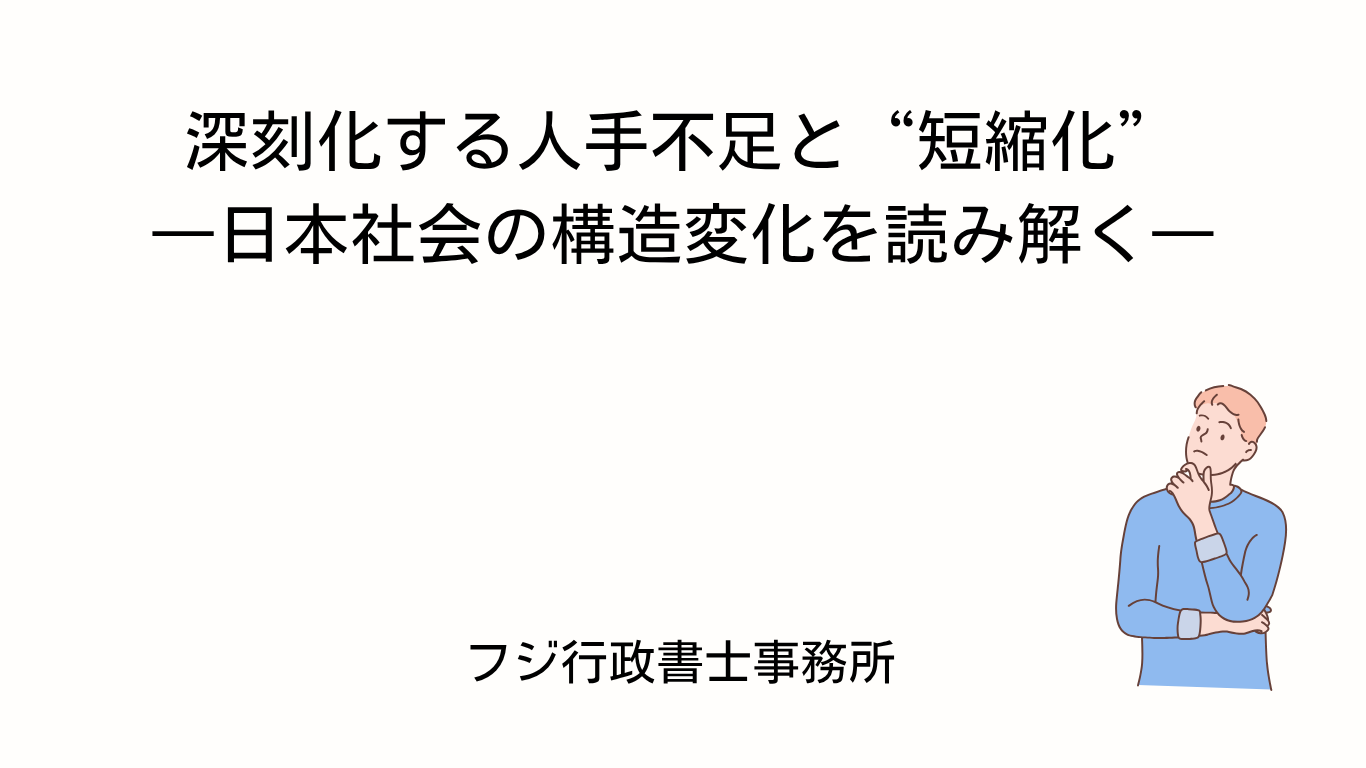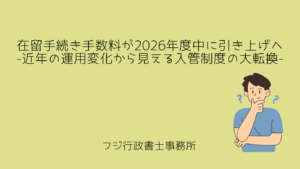広がる人手不足の波――社会全体を揺るがす課題に
Widening Labor Shortages — A Challenge Shaking Japanese Society
日本では、長年にわたる人口減少と高齢化を背景に、あらゆる分野で人手不足が深刻化しています。もはや一部の企業や業界だけではなく、社会の仕組みそのものに影響が及ぶ段階に入りつつあります。働き手が減ることで企業の活動が制約されるだけでなく、公共サービスや日常生活にもじわじわと変化が広がっています。海外の報道でもこの状況は注目されており、近年は「enshortification(短縮化)」という言葉を使って、日本の社会構造の変化を分析する論調も見られます。本記事では、人手不足の現状と背景、社会への波及、そして今後の対応の方向性を整理していきます。
In Japan, labor shortages are worsening across all sectors due to long-term population decline and aging. This is no longer limited to specific industries; it is starting to affect the very structure of society. With fewer workers, corporate activities are constrained, and public services and daily life are gradually changing. International media have also taken note of this situation, often using the term “enshortification” to describe the structural shifts occurring in Japan. This article outlines the current situation, background, social impacts, and future directions regarding the labor shortage issue.
現状:人手不足はすでに多方面に影響
Current Situation: Labor Shortages Are Affecting Many Areas
企業の現場では、すでに人材の確保が非常に難しくなっています。求人を出しても応募が集まらない、採用してもすぐに人が辞めてしまうといった声は多く、事業運営に支障をきたすケースも増えています。その影響は、経営判断やサービス提供のあり方にも及んでおり、従来の体制を維持できない企業も少なくありません。
労働人口の減少は年々進行しており、特に若年層の減少が顕著です。一方で高齢者は増えているため、社会全体として働き手のバランスが大きく崩れています。これに伴い、企業倒産や採用難が経済全体の不安要因の一つとされるようになってきました。外国人労働者の数も増加していますが、それでも需要を満たすには至っておらず、補完的な存在にとどまっています。
At the workplace level, securing workers has become extremely difficult. Companies often report that job postings attract few applicants, and even when they do hire, employees leave quickly. This is increasingly disrupting business operations, forcing companies to rethink their management and service structures.
The working-age population continues to decline each year, especially among younger generations, while the number of older people grows. This has disrupted the overall labor balance, contributing to business closures and hiring difficulties that now pose economic risks. Although the number of foreign workers is rising, it remains insufficient to meet labor demand, serving only as a partial supplement.
背景:構造的な要因が複雑に絡み合う
Background: A Complex Web of Structural Factors
日本の人手不足は、一時的な景気変動ではなく、複数の構造的要因が長期的に重なって生じています。まず大きな要因として、少子高齢化と人口減少が挙げられます。出生数が減少し続ける一方で、高齢化が進んでいるため、働き手となる人口が年々縮小しています。
また、女性や高齢者の労働参加が進んではいるものの、一人当たりの労働時間が短くなる傾向も見られ、総労働力としては十分ではありません。産業や地域によって不足の深刻さに差があることも特徴です。都市部と地方では労働力の流入出に偏りがあり、地方では過疎化によって働き手の確保がさらに難しくなっています。
制度面にも課題があります。従来の外国人労働制度は長期的な定着を前提とした仕組みではなく、現場のニーズと制度の設計にずれが生じてきました。さらに、長時間労働や賃金水準の問題など、働く環境そのものの魅力が十分とは言えない面もあります。こうした複数の要素が重なり合い、構造的な人手不足を引き起こしているのです。
Japan’s labor shortage is not a temporary economic issue but the result of multiple long-term structural factors. Chief among these are population decline and aging. With falling birthrates and a growing elderly population, the number of available workers is shrinking year by year.
Although more women and older adults are participating in the workforce, average working hours are decreasing, limiting the total available labor. The severity of shortages also varies by industry and region. Urban areas attract labor, while rural areas—affected by depopulation—struggle even more to secure workers.
Institutional challenges are also significant. Traditional foreign labor systems were not designed for long-term settlement, creating a gap between workplace needs and policy frameworks. Additionally, issues like long working hours and stagnant wages make working conditions less attractive. These factors intertwine to produce a deep-rooted labor shortage.
日常生活にも影響する“短縮化”という現象
The “Enshortification” Phenomenon Affecting Daily Life
近年、労働力不足の影響が企業内部の問題にとどまらず、人々の日常生活にも表れ始めています。海外の報道で「enshortification(短縮化)」と呼ばれる現象は、こうした変化を象徴するキーワードです。働き手やサービス提供の体制が縮小し、それまで当然のように享受できていたサービスが「減る・遅れる・縮む」形で生活に影響を及ぼすというものです。
例えば、地方の交通機関の本数が減ったり、飲食店や小売店の営業時間が短縮されたりするケースが増えています。物流や宅配の遅延、公共サービスの縮小・統廃合も見られ、社会全体の利便性が少しずつ損なわれているのが実情です。特に地方や高齢者層にとっては、これらの変化が生活に直結するため、経済的な影響だけでなく、暮らしの質に関わる重要な問題となっています。
In recent years, the impact of labor shortages has extended beyond businesses to everyday life. International media use the term “enshortification” to describe this trend: a gradual contraction of services that people once took for granted, leading to reduced availability, slower delivery, and overall downsizing.
Examples include reduced bus and train services in rural areas, shorter operating hours for restaurants and shops, delays in delivery and logistics, and consolidation of public services. These gradual shifts are eroding convenience nationwide. For rural communities and older populations, the effects are especially direct, affecting not only the economy but quality of life itself.
今後の対応の方向性
Future Directions for Addressing the Shortage
このような深刻な人手不足に対して、日本社会はさまざまな対応策を模索しています。その方向性は大きく分けて、外国人労働者の活用、技術革新の導入、そして制度改革の三つです。
まず、外国人労働者の受け入れ枠を広げる動きがあります。これまで限定的だった分野にも門戸を開き、より柔軟に人材を受け入れることで、一定の労働力を確保しようとしています。また、従来の制度を見直し、より長期的な就労や定着を可能にする仕組みへの転換も進められつつあります。
次に、技術による省力化・自動化です。ロボットやAI、自動運転といった技術の進展によって、労働力の一部を補う取り組みが広がっています。特に物流や製造業などでは、省人化による効率化が急速に進んでいます。ただし、すべての業種・地域で一様に導入できるわけではなく、技術格差が生じる可能性もあります。
制度面では、雇用、教育、社会保障などを横断的に見直す改革が進行中です。働き方の多様化や、柔軟な労働市場の整備を進めることで、限られた人材を最大限に活用することが狙いとされています。ただし、これらの取り組みは時間がかかるものであり、即効性があるわけではありません。
こうした複合的な対策をどう組み合わせ、短期的な対応と長期的な構造改革を両立させるかが、日本社会にとって大きな課題となっています。単に労働力を補うだけではなく、制度や社会全体のあり方を問い直す局面に来ていると言えるでしょう。
To address this serious labor shortage, Japanese society is pursuing several strategies, broadly divided into three areas: greater utilization of foreign labor, the introduction of new technologies, and systemic reforms.
First, Japan is expanding opportunities for foreign workers, opening more sectors to flexible employment arrangements. It is also reviewing existing systems to allow longer-term work and settlement.
Second, technology such as robotics, AI, and automated vehicles is being adopted to supplement the labor force. Sectors like logistics and manufacturing are seeing rapid efficiency gains through labor-saving measures, though not all industries or regions can adopt such technologies equally, potentially widening disparities.
Lastly, institutional reforms are underway, focusing on employment, education, and social security. By diversifying work styles and creating a more flexible labor market, these reforms aim to make the most of limited human resources. However, such measures require time and are not immediate solutions.
The challenge for Japan is to combine these different approaches effectively, balancing short-term measures with long-term structural reforms. Beyond merely filling labor gaps, this moment calls for a fundamental rethinking of societal and institutional frameworks.
最後まで読んでいただきありがとうございました。
「こんなことで相談していいの?」
—— 大丈夫です! あなたの不安に丁寧に向き合います
“Is it okay to ask about something like this?”
—— Of course! We will listen carefully and address your concerns
フジ行政書士事務所では、日本で暮らす外国人の方が安心して生活できるよう、ビザのことはもちろん、手続き・仕事・暮らしの中で感じる不安や悩みにも寄り添っています。
「誰に相談したらいいかわからない」そんなときこそ、フジ行政書士事務所にご相談ください。
あなたにとっていちばん良い形を、一緒に考えていきます。
At Fuji Gyoseishoshi Office, we support foreign residents in Japan so that they can live here with peace of mind. We are here not only for visa matters, but also to help you with procedures, work-related concerns, and daily life issues.
If you ever think, “I don’t know who to talk to,” that’s exactly when you should reach out to us.
Let’s work together to find the best solution for your situation.
※LINEをご利用でない方は、▶ お問い合わせフォームはこちら からもご相談いただけます。
* If you don’t use LINE, you can also contact us via the ▶ Contact Form.








